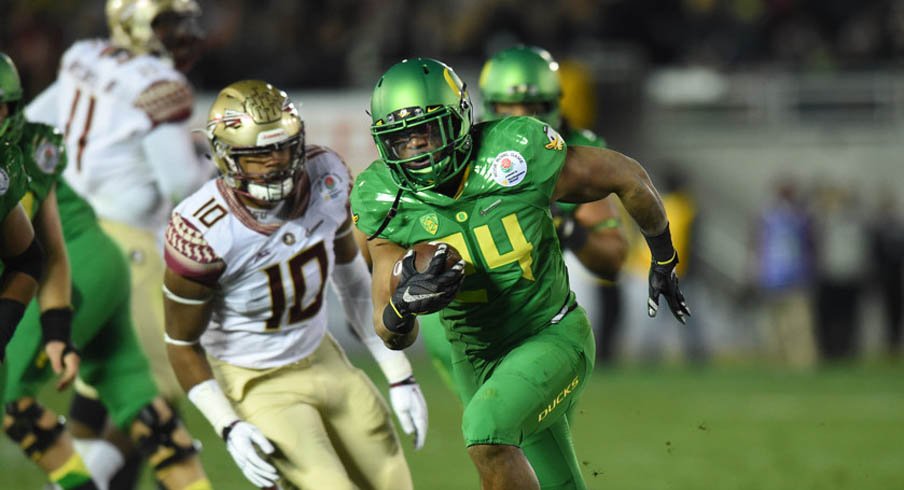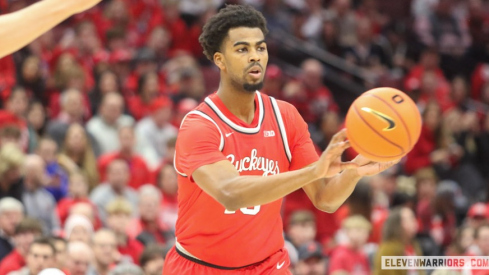For the second time in five seasons Ohio State face's Oregon's spread-to-run offense. The Ducks' offense is regularly prolific. But it is even more so this year behind Heisman Trophy quarterback Marcus Mariota.
The Buckeye defense faces a difficult challenge. But co-defensive coordinator Chris Ash's defense is designed to defend spread offenses. Ohio State needs to limit the Oregon run game and explosive plays and take advantage of opportunities to slow the Ducks' offense when they are available.
Looking in the Mirror
As Urban Meyer recently noted, there are far more similarities than differences between the Ohio State and Oregon offenses. Although much of the focus is on Oregon's spread formations and up-tempo pace, the base of the Ducks' offense is the same as Ohio State's spread – inside zone read – even down to the tailback's path. For both offenses, inside zone read is the jab that sets up most horizontal and vertical plays.
Like the Buckeyes, Oregon also run split zone. But with Oregon's split zone – given Marcus Mariota's outside speed – the H-back reads the defensive end. If the end stays home he will kick out. But if the end crashes down he will log the defensive end, creating a running lane.
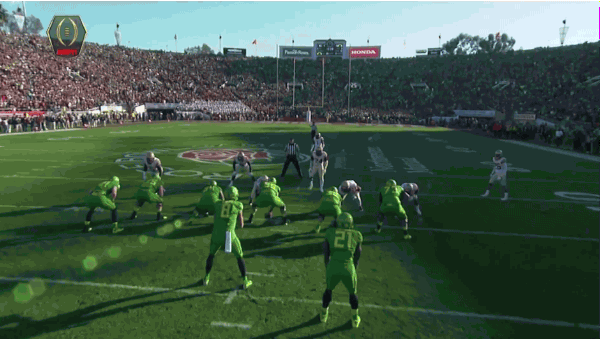
Oregon also features many of the other running plays utilized by Ohio State – most notably power, outside zone and sweep read.
And one of the most important features of both the Oregon and Ohio State run game is bash – a backside sweep tag. With bash, the offense flips the quarterback and halback's roles. The blocking scheme is for the quarterback, with the halfback running a sweep away from the blocking action. Oregon in fact goes beyond Ohio State. They not only run the play off inside zone, but will use a bash tag with outside zone and sweep read as well.
The Ohio State and Oregon similarities extend to the passing game. Both teams' passing attack primarily comes off play action. Like the Buckeyes, Oregon looks to throw the football downfield off their inside run game.
One Duck – and Buckeye – favorite is a Norm Chow and staple of the "Air Raid" offense, the Y-Cross. The goal with this play is to hold the opposite side vertical route with a safety and then hit the cross behind linebackers held by the play action.
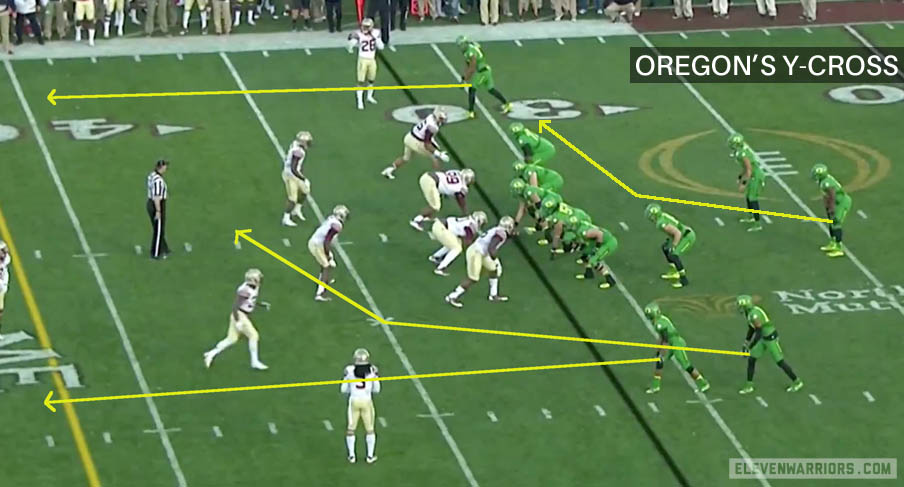
Finally, in short yardage, both offenses like using tempo to throw a sprint-out snag route.
Gettin' Wide
But as Meyer noted, if there is one area where Ohio State and Oregon differ, it is how they attack the perimeter. For Ohio State, Meyer and offensive coordinator Tom Herman primarily use jet sweeps and quick throws such as hitches and slants.
For Oregon, the wide receiver screen game remains the Ducks' primary horizontal constraint. Most Oregon run plays are packaged together with a wide receiver screen. Head Coach Mark Helfrich and offensive coordinator Scott Frost primarily use flash screens. But they will also call bubble routes. And depending on the defensive alignment, Mariota can pull the football and throw the screen pass.
For instance, against Florida State, Oregon repeatedly put their trips to the boundary.
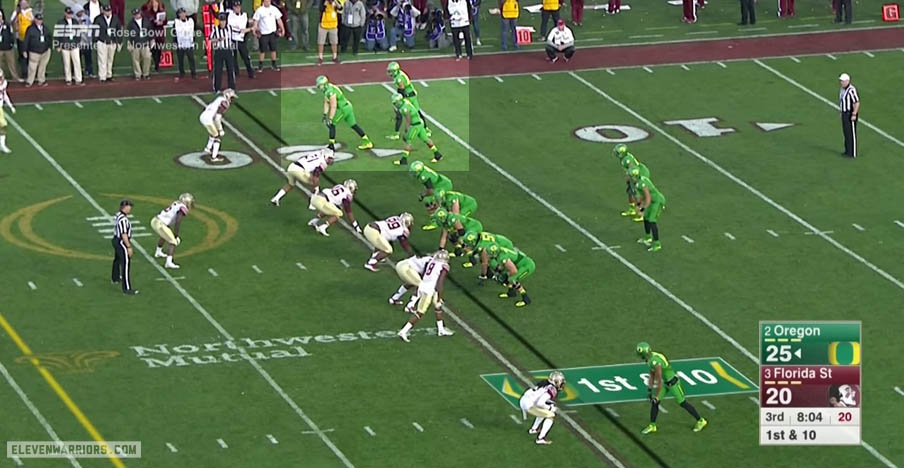
Most defenses align their back seven to the field. By putting trips to the boundary it forces the defense to make a choice. If the defense aligns to the boundary it made it easier for Oregon to run wide with outside zone.
But if the defense remains aligned to the field, Mariota can throw the flash screen.
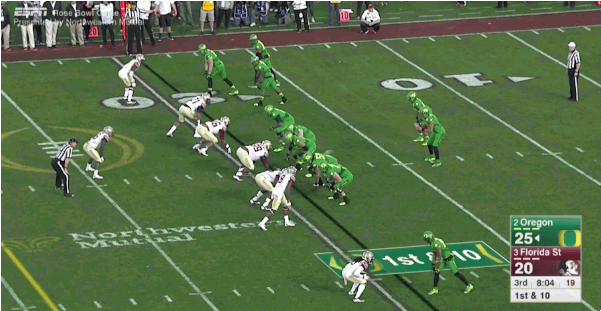
Helfrich and Frost also use horizontal routes to set up vertical throws. The hope is that defensive backs get tired of seeing throws completed underneath and jump the route, opening an easy explosive play.
For instance, against Michigan State, Oregon used horizontal routes to draw up the Spartans' cover 4 safeties and open seam routes to a slot receiver.
And of course, the Ducks average approximately :22 seconds per play. This pace becomes faster when Oregon gains first downs and remains ahead of schedule. Oregon will run the same packaged play multiple times in a row simply to ensure the tempo remains high. The pressure is on the defense to line up and play sound.
Made for This
It should come as no surprise that Oregon's offense revolves around Mariota. The Ducks have two young, talented tailbacks. After overcoming injuries, the Oregon offensive line has rounded into a fairly strong unit – particularly at the important positions of left tackle and center. And they have solid wide receivers – though the unit has been weakened with the loss of receivers Devon Allen and Darron Carrington and tight end Pharaoh Brown. But Mariota makes everyone on the Oregon offense look better.
Mariota is perhaps the ideal fit for shotgun spread offenses. It is not just Mariota's accuracy or speed. Mariota repeatedly keeps drives alive by evading pressure. But in so doing he keeps his eyes downfield, making plays outside the play design with his arm or his feet. Mariota's ability to evade pressure was critical in Oregon's early season win over Michigan State.
Mariota is also an adept ball handler with read plays. And although he does not carry on designed runs extensively, Helfrich and Frost put the ball in his hands when they need a play. This generally comes in the form of a bash tag where Mariota keeps behind the designed blocking scheme.
For Ohio State, co-defensive coordinator Chris Ash's 4-3 over, cover 4 defense was designed with spread offenses such as Oregon in mind. Ash puts his corners in press coverage to limit quick throws, uses cover 4 for combination coverages against multiple wide receivers, and features a hybrid walkout linebacker to defend the wide side flat. While this obviously does not guarantee success, it at least allows the Buckeyes to operate within their base scheme.
Against Oregon, the Buckeyes must better defend the run, where Oregon has a statistical advantage. Oregon had success running power to the boundary against Michigan State's cover 4 defense. Given Alabama's success running to the boundary in the Sugar Bowl, Oregon will surely utilize the same strategy.
Ash is willing to concede some rushing yards partially by design. But the Ohio State secondary cannot sit in cloud coverage and provide minimal alley support like they did to defend Amari Cooper. But against Oregon there is not a need to do so.
Expect the Buckeyes to use more standard quarters' coverage. Given the Ducks tempo, it is critical that the secondary communicate well and execute combo coverages correctly to ensure Oregon does not get easy explosive plays off the threat of underneath routes.
At the micro level, the Ohio State defensive line – particularly tackles Michael Bennett and Adolphus Washington – must control the line of scrimmage. If the Buckeye interior can limit Oregon's inside zone play without help, it limits Oregon's numbers advantage and makes it more difficult for the Ducks to use constraint plays off the run.
The Ohio State defense has been very solid against wide receiver screens all season. This is partially because of press corner coverage – but also because of walkout linebacker Darron Lee. Perhaps no player is more important against Oregon than Lee. Playing in the wide field overhang area between the tackle and slot, Lee has the quickness to attack wide receiver screens and the strength to beat wide out blocks. Lee must be able to apply himself against the screen game and the run.
Oregon will gain yards and score points. But the Buckeye defense must take advantage of opportunities. If the Buckeyes can place Oregon behind schedule it slows down the Ducks' offense.
And when Ohio State forces Oregon into third and long they must win those situations. Oregon is relatively less efficient in must pass situations – where the Buckeye defense is strongest.
Oregon is more likely to use five man pass protections than Ohio State – providing Ash third down zone blitz opportunities against a line that suffered a series of injuries. Pass rushers must maintain their rush lane discipline to not let Mariota escape the pocket. The more zero or negative plays the defense can create, the more likely Oregon can be forced to punt or limited to field goals. The Buckeyes will go a long way towards helping their cause if they can force a couple of three and outs – which is where the up-tempo offense comes back to harm Oregon.
